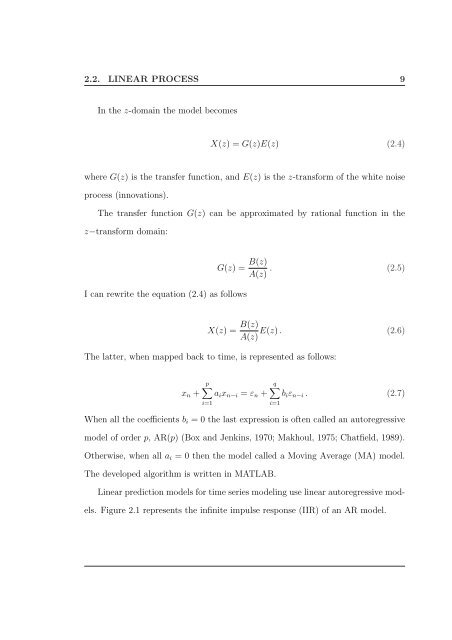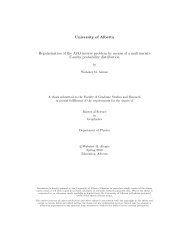Soner Bekleric Title of Thesis: Nonlinear Prediction via Volterra Ser
Soner Bekleric Title of Thesis: Nonlinear Prediction via Volterra Ser
Soner Bekleric Title of Thesis: Nonlinear Prediction via Volterra Ser
Create successful ePaper yourself
Turn your PDF publications into a flip-book with our unique Google optimized e-Paper software.
2.2. LINEAR PROCESS 9<br />
In the z-domain the model becomes<br />
X(z) = G(z)E(z) (2.4)<br />
where G(z) is the transfer function, and E(z) is the z-transform <strong>of</strong> the white noise<br />
process (innovations).<br />
The transfer function G(z) can be approximated by rational function in the<br />
z−transform domain:<br />
I can rewrite the equation (2.4) as follows<br />
G(z) = B(z)<br />
. (2.5)<br />
A(z)<br />
X(z) = B(z)<br />
E(z) . (2.6)<br />
A(z)<br />
The latter, when mapped back to time, is represented as follows:<br />
p<br />
q<br />
xn + aixn−i = εn + biεn−i . (2.7)<br />
i=1<br />
i=1<br />
When all the coefficients bi = 0 the last expression is <strong>of</strong>ten called an autoregressive<br />
model <strong>of</strong> order p, AR(p) (Box and Jenkins, 1970; Makhoul, 1975; Chatfield, 1989).<br />
Otherwise, when all ai = 0 then the model called a Moving Average (MA) model.<br />
The developed algorithm is written in MATLAB.<br />
Linear prediction models for time series modeling use linear autoregressive mod-<br />
els. Figure 2.1 represents the infinite impulse response (IIR) <strong>of</strong> an AR model.









